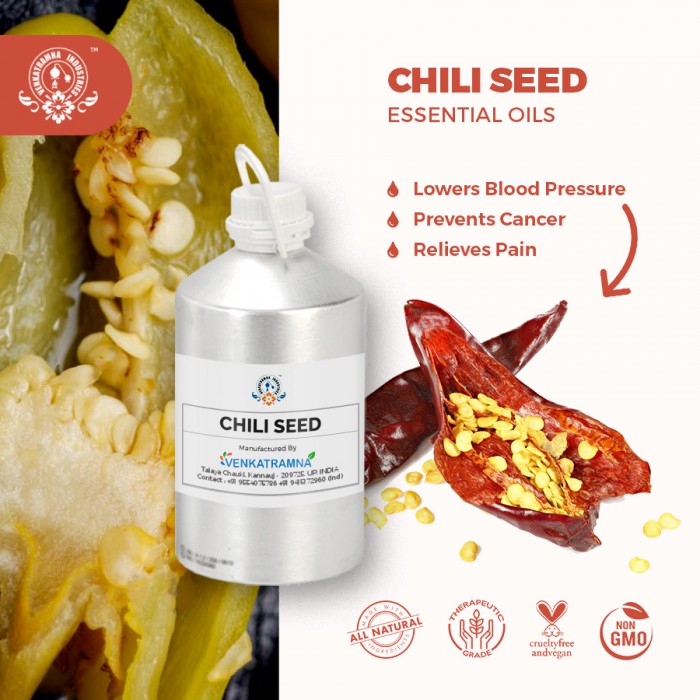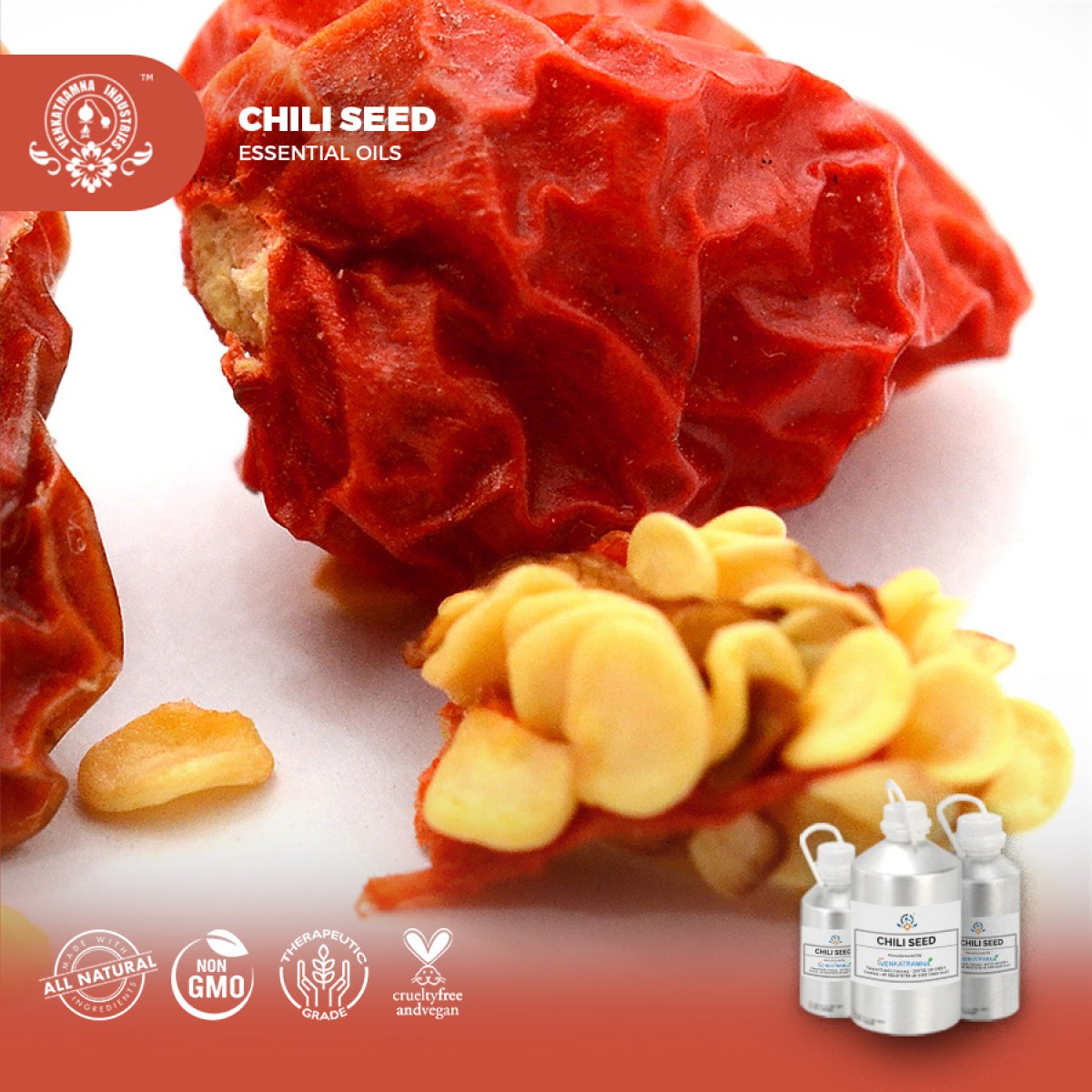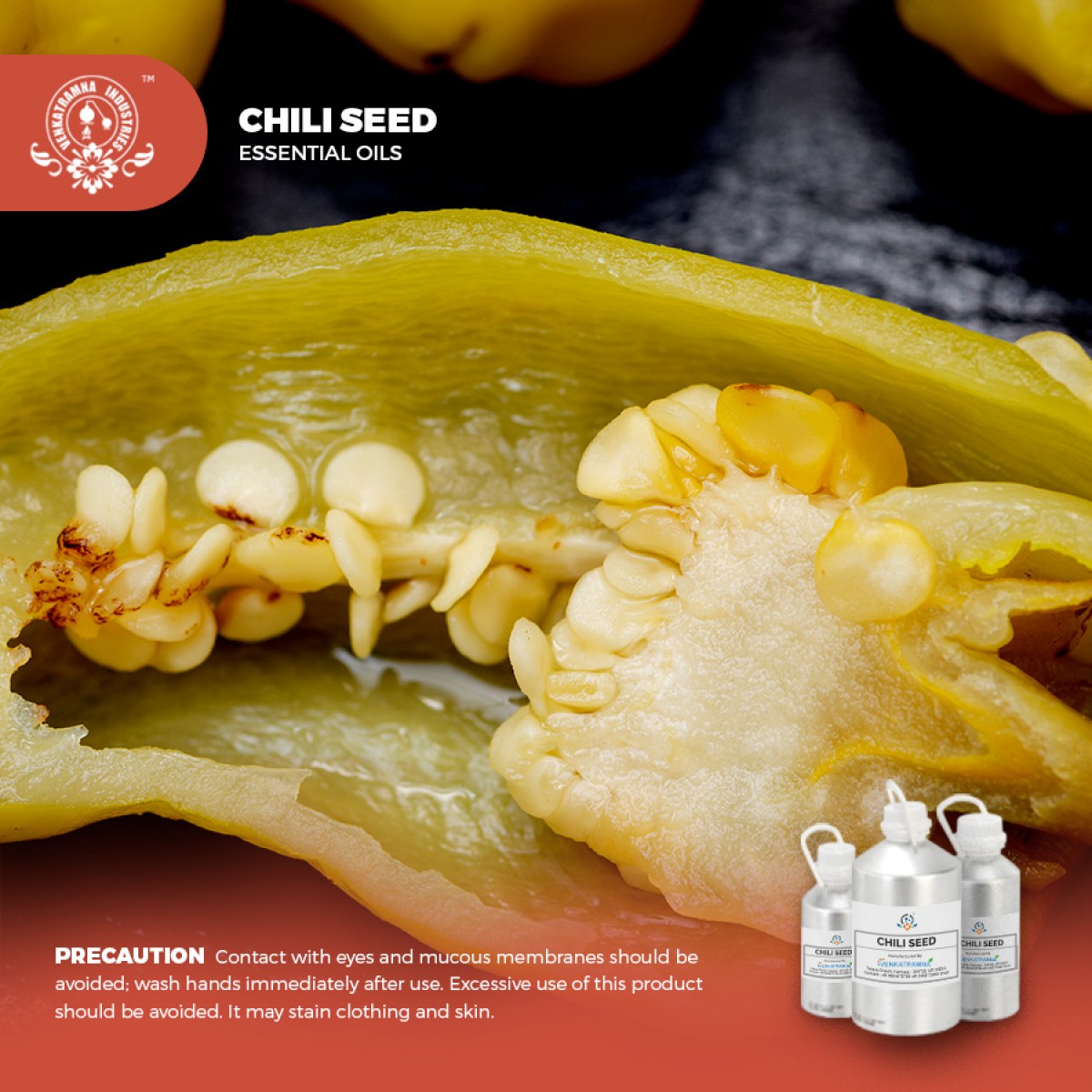Botanical Name: Capsicum annum Common name: Pepper, Chilly Plant fami Read More
|
Botanical Name: |
Capsicum annum |
|
Common name: |
Pepper, Chilly |
|
Plant family: |
Solanaceae |
|
Genus: |
Capsicum |
|
Appearance/Color: |
Viscous dark red liquid |
|
Odor: |
Hot, spicy, pepper like |
|
Blends With: |
None |
|
Origin |
India |
Chilli or hot
pepper (Capsicum
annuum L.,) is economically most important and valuable spice
and vegetable
crop throughout the world. Chilli is native to New Mexico and
the Portuguese introduced chillies in Indo-Pak subcontinent from Brazil in 16th
century. India is the world’s largest producer, consumer and exporter of
chillies in the world, contributing 40% of the total world production. Other
major chillies producing countries are China, Bangladesh, and Peru.
Chili seed essential oil is
derived from the steam distillation of hot pepper seeds. The result is a
semi-viscous dark red essential oil known as chili seed oil. It has wonderful
therapeutic properties including the ability to stimulate blood circulation making
it especially beneficial for healing wounds and aiding in hair growth by
delivering vital nutrients to the scalp.
Peppers were one of the earliest
plants cultivated in the New World. Archeological evidence suggests that
peppers were used as food ingredients in Peru more than 8,000 years ago.
Columbus mistakenly applied the label ‘pepper’ to the plant he found growing in
Caribbean gardens, likely confusing it with the highly prized but botanically
unrelated black pepper. Within 100 years, peppers had spread around the world
and today constitute the defining ingredient in traditional cuisines worldwide,
including countries such as Italy, Thailand, Hungary, India, Spain, China and
Holland.
Botanically, most cultivated peppers today are Capsicum annuum (most common), C. frutescens (tabasco), C. chinense (habanero), or crosses within and among these various species.
DISCLAIMER
The complete range of conditions
or methods of use are beyond our control therefore we do not assume any
responsibility and expressly disclaim any liability for any use of this
product. Information contained herein is believed to be true and accurate however,
all statements or suggestions are made without warranty, expressed or implied,
regarding accuracy of the information, the hazards connected with the use of
the material or the results to be obtained from the use thereof. Compliance
with all applicable federal, state, and local laws and local regulations
remains the responsibility of the user.
The FDA has not evaluated the
statements on this website. No claims are made by Venkatramna Industries as to
the medicinal value of any products from vriaroma.com or by us. The information
presented here is for educating our customers about the traditional uses of
essential oils and is not intended to diagnose, treat, cure, or prevent any
disease. You are responsible for understanding the safe application of these products.
If you have any questions, please call or email us for further information.
As per NAHA guidelines, New Directions Aromatics
(NDA) does not recommend the ingestion of essential oils. It is imperative to
consult a medical practitioner before using Essential Oils for therapeutic
purposes. Pregnant and nursing women and those taking prescription drugs are
especially advised not to use this product without the medical advice of a
physician. The oil should always be stored in an area that is inaccessible to
children, especially those under the age of 7.
Chilli is vulnerable to several
pathogens, including the viral diseases and till date 65 viruses are reported
to infect chilli resulting in heavy yield losses. Mostly, the viruses are
spread or transmitted by infected seeds,
insects and or by the mechanical tools. Most of the viral
diseases are difficult to diagnose due to significant overlap of
symptomatology. Symptoms produced by different viruses are mosaic pattern on
leaves, yellowing, ring spots, leaf deformation, curling of leaves, and
stunting of plants.
Chili Seed Essential Oil in
Pharma
Capsicum (Capsicum annuum), also
known as cayenne pepper, has been used orally for upset
stomach, toothache, poor circulation, fever, hyperlipidemia,
and heart disease prevention. Capsicum can be used topically to treat pain
associated with osteoarthritis, shingles, rheumatoid
arthritis, post-herpetic neuralgia, trigeminal
neuralgia, diabetic neuropathy, fibromyalgia, and back pain. Others
have used capsicum for relief of muscle spasms and even as a gargle
for laryngitis.
Essence of Chili Seed
Essential Oil
Peppers form a significant part
of the human diet in many parts of the world. Fruits are consumed in fresh,
cooked, or processed forms. Fresh peppers are often used in salads. Chilies are
also sold as frozen, canned, dried (whole or crushed pieces), and pickled
fruit. Fruit is also processed into various fermented products, powders,
sauces, curry pastes, and salsas. Dried chilies are often ground into powders
and added into various culinary preparations and other dishes. Fresh or dried
chilies are also used to make hot sauce. Chili in the form of powder or paste
is a vital ingredient of Indian curries. Fresh market types, such as bell,
Cuban, and squash,
are usually non-pungent and eaten raw or stir-fried.
Chili seed essential oil is a
unique addition to cosmetic applications, personal care formulations, soaps,
perfumery, incense, candles, and aromatherapy.
COMMON USAGE
·
Prevents chronic disease
·
Stimulates immune system
·
Relieves stomach issues
·
Clears sinus congestion
·
Prevents macular degeneration
·
Relieves pain
·
Improves cognitive levels
·
Prevents cancer
·
Reduces skin inflammation
·
Lowers blood pressure
Ingredients:
|
S.No |
Key Constituents |
Strength (%) |
|
1 |
Capsaicin |
0.1-0.5 |
|
2 |
Capsaicinoids |
65-75 |
|
3 |
Palmitic acid |
15,98 |
|
4 |
Diethylhxyl adipate |
2,02 |
|
5 |
Methyl linoleate |
1,58 |
|
6 |
Aliphatic dimethyl L ester |
4,18 |
|
7 |
Oleic acid |
12,26 |
|
8 |
Linoleic acid |
47,09 |
|
9 |
b-Monolinolein |
6,33 |
TOXICOLOGICAL
INFORMATION
Safety Summary
·
Hazards; May cause Skin Irritation.
·
Cautions: Prevent direct contact.
·
Toxicological Data:
o
OralLD50 (rat) : > 3,000 mg/Kg
o
Dermal LD50 (Rabbit) : >2500mg/Kg
o
Inhalation LC50 (rat) : >10,000gm/m3/4H
o
Skin: Mild Irritant (human)
Organ Specific Effects
·
Adverse skin reactions: May cause skin irritation.
Other Details Are not available.
No adverse health effect expected
if the product is handled in accordance with this Safety Data Sheet and the
product label. Symptoms or effects that may arise if the product is mishandled
and over exposure occurs are:
·
Ingestion: No adverse effects expected. However,
large amounts cause Nausea and vomiting.
·
Eye Contact: May be an eye irritant.
·
Skin Contact: Contact with skin may
result in irritation. Repeated prolonged skin contact may lead allergic contact
dermatitis.
·
Inhalation: Breathing in vapor, mists or
aerosols may produce respiratory irritation.
ECOLOGICAL
INFORMATION
·
Acute aquatic toxicity: Not determined
·
Persistence and degradability: Not available.
·
Bioconcentration Factor: Not determined
·
Mobility in soil: Not available.
·
Results of PBT and vPvB assessment: Not
determined
Do not discharge into the
environment, especially not into waterways, sewers and the environment.





 MSDS-Chili_Seed.pdf
MSDS-Chili_Seed.pdf




